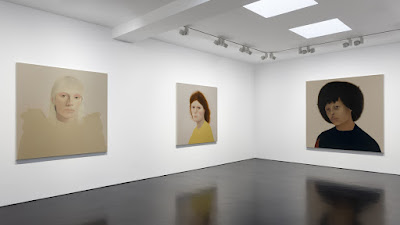Sarah Ball at Stephen Friedman Gallery
There is a certain joy in simplicity. When most of us spend so much time between the virtual realm and busy, polluted environments, with unruly workloads meandering and crashing somewhere in between, silence is often a treat, a luxury. So how about a visual silence? A presence that is not shouting to be seen or heard, but stands with you, almost in a mutual exchange of acknowledgment and still being.
This was my initial thought process upon seeing British artist Sarah Ball's work at Stephen Friedman Gallery. The vast brightness of gallery walls can sometimes be clinical and off-putting, but with these works, dominated by their soft and muted palettes, the hues seem to melt into the immediate environment, compelling us to view and investigate, yet keeping us at arm's length. The sitters are not presented as bold, demanding personalities; instead, we feel that the works are individuals showing us who they are, neither labelling themselves, nor being labelled. There is a real quietness to the work on display, made even more prominent by the subtle curation and ample space between canvases. Presenting individuals as they are in such simple visual terms resembles an antithesis to reality television culture, whereby contestants compete to be the most memorable, the most outrageous. Here, the people in Ball's works have a stillness and a subdued element to them, which many people will find relatable in 2022, two years since the first pandemic lockdown.
There are ten large-scale portraits as part of her untitled show, with one tiny depiction at the end. Their huge sizes, from 200cm x 160cm to 120cm x 120cm, are a big force in the space. When it comes to portraits, their history plays a huge part in how we perceive them; I think particularly of their majestic nature in situ at the likes of the National Portrait Gallery, and the ways in which the viewer is supposed to be made to feel small and inadequate. Interestingly, and perhaps this has something to do with the fact that we do not know the people Ball has painted, the works are not looming status symbols. In fact, we are not given any information as to who the subject matters are, aside from names in the paintings' titles, again a stunning contrast to the accessible level of information we have at our fingertips thanks to social media and any Google search we desire.
Another element of this body of work which is gentle and quiet, yet powerfully so, is the commentary on gender identity. The binary is thrown out the door here, as we are able to witness Ball's drive to not only subvert the norm, but illuminate its staleness. Norms, expectations and aesthetics of the gender binary are unimportant, and in withholding this detail (as every painting seems to have a gender neutral presentation), we are reminded that we do not have automatic permission to know their personal information. With thoughts on consent in a wider social context, I think of the fetishisation of queer people; the ways in which Black people, especially women, experience having their hair touched without consent; the way women and gender non-conforming people are harassed and touched unnecessarily. What information and access do we really need to share with strangers? An argument between visibility and invisibility, pride and opacity, emerges.
It is certainly encouraging to see what I would call "quiet art" being celebrated in a gallery as established as Stephen Friedman. We are told that the artist uses a range of sources to produce her portraits, "including newspaper cuttings, archival photographs and social media", so perhaps the distance between these works and the buzzy, frantic world of social media and its unboundaried consent issues aren't so far after all. This level, and indeed process, of anonymity, is interesting, and suggests that the artist could have the same impression of, and relationship to, these people as her audience; they are strangers to us all. Ball's exhibition of portraits feels like how social media could be if it wasn't dominated by alien algorithms and Big Data; if we weren't all oversharing, trying too hard to impress, putting on a facade. There is very little expression in the faces of the artist's sitters, and the muted, dark and beige backgrounds offer no clues as to where they are situated, socially or physically. Again, this is none of our business. Instead, we are granted permission to luxuriate in the artist's skilful painting work; the stories of Ball's subjects belong to them, and no one else.





